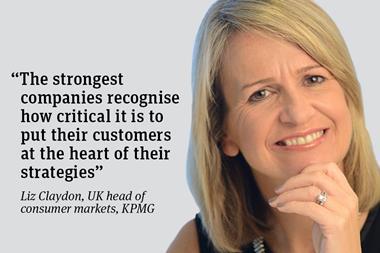What lessons are to hand for Sir Ken Morrison in a study of earlier company marriages? Duncan Brown has some tips for avoiding shareholder disappointment and the loss of key talent
With the arranged marriages of Morrisons/Safeway and Carlton/ Granada progressing, the takeover of ASK by Pizza Express and Comcast’s audacious bid for Disney, the City financiers are delighted. Who will be next - Austin Reed, House of Fraser or Sainsbury? Let the good times and bonuses roll!
But good for whom? Research demonstrates that the disappointments of removed senior executives are often experienced by a wider population and without a Criado-Perez size compensation package.
In one North American study, fewer than a third of takeovers produced positive shareholder returns.
The retailing landscape on this side of the Atlantic is similarly scarred, with Somerfield’s troubles since its takeover of Kwik Save in 1998 and Carrefour’s muddled merger with Promodès.
The Chartered Institute of Personnel and Development’s research project, Organising for Success, has involved more than 800 chief executives and directors, including firms such as Cadbury Schweppes and Unilever. These businesses are restructuring in a major way every three years. Smaller scale, internal reorganisation is virtually continuous. Yet participants admit a majority of these changes are failing.
The primary causes of failure are people-related: over-ambitious directors, lack of a clear strategy, poor project management, the loss of key talent, high levels of internal conflict and also duplication of activities.
Senior executives often seem to develop the blueprint for change, which is then rolled out by uninvolved managers across uncomprehending employees, with the HR department left to pick up the pieces.
In one recruitment consultancy acquired by a City firm, three-quarters of the staff left within 12 months of the acquisition.
So, aside from ‘think twice’, what advice can we give to Sir Ken and those about to enter into similar unions? Our research draws out four lessons. First, ensure your leadership team has the expertise to implement an acquisition or similar major change. It needs to put in place a strategy that makes realistic estimates of the risks, returns, costs and timescales.
In the CIPD study, the quality of leaders and their support was frequently mentioned and over half the participants will, in future, make greater use of external expertise.
Interestingly, Morrisons has set out a clear strategy for the enlarged firm and, for the first time, hired external consultants.
Second, take a comprehensive approach, integrating changes in structure, business processes and systems. Give strong attention to the HR issues, including:
n During planning and due diligence stages, what is the cultural fit between the two organisations? What is the future people strategy? What are the human risks, such as loss of key staff?
n When the deal is being delivered, what are the new roles and what selection process will be used? How will career structures, appraisal and reward systems need to change? What are staff thinking and how can we build a sense of shared purpose? In our research, 60% of firms said such issues would get more prominence in future.
Third, involve your HR department at all stages in the process, another factor correlating with successful reorganisation in the research.
Finally, engage in extensive communication and involvement with employees. Less than a third of our research companies let employees influence their reorganisation. One respondent told us “very little input was permitted from me and I headed a major function”.
Yet when the merger of GlaxoWellcome and SmithKlineBeecham took place, dozens of staff teams worked on the new organisation, which hugely facilitated the integration.
Initial signs at Morrisons/Safeway look good. Morrisons has a good employee relations record while Jim White, Safeway’s HR director, has been implementing a comprehensive programme to maintain performance and retain staff.
In mergers and reorganisations, UK companies need to pay greater attention to people, to build their management capability and achieve the employee commitment. The message from the research is: do it properly, in a people-focused way, or don’t do it at all.
n Duncan Brown is assistant director general, Chartered Institute of Personnel and Development
With the arranged marriages of Morrisons/Safeway and Carlton/ Granada progressing, the takeover of ASK by Pizza Express and Comcast’s audacious bid for Disney, the City financiers are delighted. Who will be next - Austin Reed, House of Fraser or Sainsbury? Let the good times and bonuses roll!
But good for whom? Research demonstrates that the disappointments of removed senior executives are often experienced by a wider population and without a Criado-Perez size compensation package.
In one North American study, fewer than a third of takeovers produced positive shareholder returns.
The retailing landscape on this side of the Atlantic is similarly scarred, with Somerfield’s troubles since its takeover of Kwik Save in 1998 and Carrefour’s muddled merger with Promodès.
The Chartered Institute of Personnel and Development’s research project, Organising for Success, has involved more than 800 chief executives and directors, including firms such as Cadbury Schweppes and Unilever. These businesses are restructuring in a major way every three years. Smaller scale, internal reorganisation is virtually continuous. Yet participants admit a majority of these changes are failing.
The primary causes of failure are people-related: over-ambitious directors, lack of a clear strategy, poor project management, the loss of key talent, high levels of internal conflict and also duplication of activities.
Senior executives often seem to develop the blueprint for change, which is then rolled out by uninvolved managers across uncomprehending employees, with the HR department left to pick up the pieces.
In one recruitment consultancy acquired by a City firm, three-quarters of the staff left within 12 months of the acquisition.
So, aside from ‘think twice’, what advice can we give to Sir Ken and those about to enter into similar unions? Our research draws out four lessons. First, ensure your leadership team has the expertise to implement an acquisition or similar major change. It needs to put in place a strategy that makes realistic estimates of the risks, returns, costs and timescales.
In the CIPD study, the quality of leaders and their support was frequently mentioned and over half the participants will, in future, make greater use of external expertise.
Interestingly, Morrisons has set out a clear strategy for the enlarged firm and, for the first time, hired external consultants.
Second, take a comprehensive approach, integrating changes in structure, business processes and systems. Give strong attention to the HR issues, including:
Third, involve your HR department at all stages in the process, another factor correlating with successful reorganisation in the research.
Finally, engage in extensive communication and involvement with employees. Less than a third of our research companies let employees influence their reorganisation. One respondent told us “very little input was permitted from me and I headed a major function”.
Yet when the merger of GlaxoWellcome and SmithKlineBeecham took place, dozens of staff teams worked on the new organisation, which hugely facilitated the integration.
Initial signs at Morrisons/Safeway look good. Morrisons has a good employee relations record while Jim White, Safeway’s HR director, has been implementing a comprehensive programme to maintain performance and retain staff.
In mergers and reorganisations, UK companies need to pay greater attention to people, to build their management capability and achieve the employee commitment. The message from the research is: do it properly, in a people-focused way, or don’t do it at all.













No comments yet